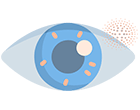Corneal Dystrophies Precision Panel
Corneal Dystrophies (CD) are a group of genetic, commonly progressive, eye disorders in which abnormal material often accumulates in the clear outer layer of the eye (the cornea).


Corneal Dystrophies (CD) are a group of genetic, commonly progressive, eye disorders in which abnormal material often accumulates in the clear outer layer of the eye (the cornea). The onset of symptoms varies between patients, from asymptomatic from significant vision impairment cases. This condition can either affect one or both eyes, and the intensity of symptoms in that case is not necessarily equal. The age of onset and specific symptoms vary among the different forms of corneal dystrophy. CD can be grouped by which layers of the cornea is affected:
Anterior/Superficial Coneal Dystrophies.
Stromal Corneal Dystrophies.
Posterior Corneal Dystrophies.
The Igenomix Corneal Dystrophies Precision Panel can be used to make an accurate and directed diagnosis leading to a better management and prognosis of the disease. It provides a comprehensive analysis of the genes involved in this disease using next-generation sequencing (NGS) to fully understand the spectrum of relevant genes involved.
The clinical utility of this panel is:
Møller, H. U., & Sunde, L. (2013). Prevalence of corneal dystrophies in the United States: estimates from claims data. Investigative ophthalmology & visual science, 54(1), 387. https://doi.org/10.1167/iovs.12-11211
Aggarwal, S., Peck, T., Golen, J., & Karcioglu, Z. A. (2018). Macular corneal dystrophy: A review. Survey of ophthalmology, 63(5), 609–617. https://doi.org/10.1016/j.survophthal.2018.03.004
Bourges J. L. (2017). Corneal dystrophies. Journal francais d’ophtalmologie, 40(6), e177–e192. https://doi.org/10.1016/j.jfo.2017.05.003
Soh, Y.Q., Kocaba, V., Weiss, J.S. et al. Corneal dystrophies. Nat Rev Dis Primers 6, 46 (2020). https://doi.org/10.1038/s41572-020-0178-9
Matthaei, M., Hribek, A., Clahsen, T., Bachmann, B., Cursiefen, C., & Jun, A. S. (2019). Fuchs Endothelial Corneal Dystrophy: Clinical, Genetic, Pathophysiologic, and Therapeutic Aspects. Annual review of vision science, 5, 151–175. https://doi.org/10.1146/annurev-vision-091718-014852